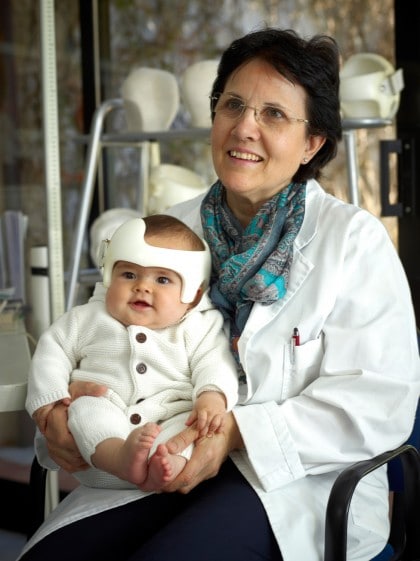
Experts in the diagnosis and treatment of skull deformities with DOC Band® method
After the campaigns to “Back to sleep”, the incidence of Sudden Infant Death has dropped by 2/3. Our advice is therefore to put newborn babies to sleep on their backs. Plagiocephaly can be treated, sudden death cannot.
But sleeping on your back is a predisposing factor to have cranial deformities. Therefore, combine the strict supine position with the position towards the right side and towards the left side. You have 180 possibilities to place your baby sleeping on his back at night and during daytime naps. Don’t always use the same one.
If you often get up at night to care for your baby, follow these guidelines:
If your baby does not need more care and sleeps for many hours at a time, follow these guidelines:
We advise you to use soft pads (towels, pillows, etc.) under the sheet, this will be your best help. If your baby is treated in an anti-reflux chair, try to follow the same guidelines.

Any newborn should sleep on their back with their head and body turned alternately to each side, with the supine (or dorsal) position being preferred to the lateral position. When the newborn is awake, it should be placed on its belly to get used to this position in which it does its first physical exercises.
Alternate lateral decubitus is a good means of preventing postural plagiocephaly and also reducing the risk of Sudden Infant Death Syndrome (SIDS) at the same time.
But beware: the relative risk of SIDS for babies who sleep on their side is 2.2 times higher compared to those who sleep supine. Other drawbacks of lateral decubitus is that it is unstable compared to supine. If it is very strict they can turn to the prone position.
The recommendation, then, would be for parents to alternate, in a similar way, the centered position of the head (nose at zenith), the partial turn to the right and the partial turn to the left. This rotation of the head position should be done in the neonatal period to prevent the newborn from adopting the habit of a single head position and thus from starting to develop occipital flattening.
When, as infants under one year of age grow older, they learn to turn on themselves and sleep spontaneously on their tummy, we recommend supine rest since there is no consensus when it comes to establishing when prone rest ceases to be dangerous.
When the baby is awake or wants to play, the prone position is highly recommended for supervised play. At this time there is no risk for SIDS but it is when their motor skills can best develop.
When plagiocephaly appears, a combination of appropriate postural changes should be made (mainly sleeping on the opposite side, dedicating as much time as possible to being face down doing physical activity on the opposite side to the flattening side, holding it in the arms) and muscle physiotherapy of the neck intensive, daily and done at home apart from the work of the physiotherapist.
After 3 or 4 months of age, depending on the degree of severity, the use of dynamic cranial orthopedic bands must be added to this treatment to restore normalcy to affected patients. Between that period and 12 months of age is when the best results are obtained.
As the infant gets older, the chances of improvement decrease.
After 2 years of age, an orthopaedic treatment is no longer possible.
Please consider the “Tummy time” guide.
It is the second weapon that we have at our disposal to avoid positional deformities. Follow the examples you can find in the TUMMY TIME guide.

Experts in the diagnosis and treatment of skull deformities with DOC Band® method
| Name | Domain | Purpose | Expiry | Type |
|---|---|---|---|---|
| wpl_user_preference | www.plagiocefalia.com | GDPR Cookie Consent Preferences | 1 year | HTTP |
INFORMACIÓN BÁSICA SOBRE PROTECCIÓN DE DATOS | |
Responsable | Dr. Joan Pinyot Garròs (en adelante, “European Craniofacial Medical Center”) |
Finalidad | Gestionar las solicitudes de diagnóstico inicial sobre deformidades craneales en bebés realizadas través del formulario web habilitado. |
Legitimación | Consentimiento del interesado/a. |
Destinatarios | No se cederán datos, salvo imperativo legal. |
Transferencias Internacionales | No se realizan transferencias internacionales de datos. |
Derechos | Acceder, rectificar y suprimir los datos, así como otros derechos, como se explica en la información adicional. |
Información adicional | Puede consultar la información adicional y detallada sobre Protección de Datos en este enlace. |
Antes de rellenar el formulario debe leer la información de nuestra política de protección de datos y nuestra condiciones de uso.
INFORMACIÓN BÁSICA SOBRE PROTECCIÓN DE DATOS | |
Responsable | Dr. Joan Pinyot Garròs (en adelante, “European Craniofacial Medical Center”) |
Finalidad | Dar respuesta a las solicitudes de contacto enviadas a través del formulario web habilitado. |
Legitimación | Consentimiento del interesado/a. |
Destinatarios | No se cederán datos, salvo imperativo legal. |
Transferencias Internacionales | No se realizan transferencias internacionales de datos. |
Derechos | Acceder, rectificar y suprimir los datos, así como otros derechos, como se explica en la información adicional. |
Información adicional | Puede consultar la información adicional y detallada sobre Protección de Datos en este enlace. |